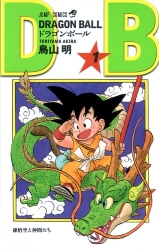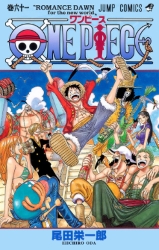Who Were the Big Three?
The "Big Three" refers to three of the most influential manga series of the 2000s: Naruto, Bleach, and One Piece. These series not only dominated Shonen Jump's pages but also redefined what manga could achieve in terms of storytelling, world-building, and cultural impact.

Naruto
Naruto[a] is a Japanese manga series written and illustrated by Masashi Kishimoto. It tells the story of Naruto Uzumaki, a young ninja who seeks recognition from his peers and dreams of becoming the Hokage, the leader of his village. The story is told in two parts: the first is set in Naruto's pre-teen years (volumes 1–27), and the second in his teens (volumes 28–72). The series is based on two one-shot manga by Kishimoto: Karakuri (1995), which earned Kishimoto an honorable mention in Shueisha's monthly Hop Step Award the following year, and Naruto (1997).
Naruto was serialized in Shueisha's shōnen manga magazine Weekly Shōnen Jump from September 1999 to November 2014, with its chapters collected in 72 tankōbon volumes. Viz Media licensed the manga for North American production and serialized Naruto in their digital Weekly Shonen Jump magazine. Part I of the manga was adapted into an anime television series by Pierrot and Aniplex, which ran for 220 episodes from October 2002 to February 2007 on TV Tokyo. A second series, which adapts material from Part II of the manga, is titled Naruto: Shippuden and ran on TV Tokyo for 500 episodes from February 2007 to March 2017. Pierrot also developed 11 animated films and 12 original video animations (OVAs). The franchise includes light novels, video games, and trading cards developed by several companies. The story of Naruto continues in Boruto, where Naruto's son Boruto Uzumaki creates his own ninja way instead of following his father's.
Naruto is one of the best-selling manga series of all time, having 250 million copies in circulation worldwide in 47 countries and regions, with 153 million copies in Japan alone and remaining 97 million copies elsewhere. It has become one of Viz Media's best-selling manga series; their English translations of the volumes have appeared on USA Today and The New York Times bestseller list several times, and the seventh volume won a Quill Award in 2006. Reviewers praised the manga's character development, storylines, and action sequences, though some felt the latter slowed the story down. Critics noted that the manga, which has a coming-of-age theme, makes use of cultural references from Japanese mythology and Confucianism.

Bleach
Bleach (stylized in all caps) is a Japanese manga series written and illustrated by Tite Kubo. It follows the adventures of a teenager Ichigo Kurosaki, who obtains the powers of a Soul Reaper—a death personification similar to a Grim Reaper—from another Soul Reaper, Rukia Kuchiki. His new-found powers allow him to take on the duties of defending humans from evil spirits and guiding departed souls to the afterlife, and set him on journeys to various ghostly realms of existence.
Bleach was serialized in Shueisha's shōnen manga magazine Weekly Shōnen Jump from August 2001 to August 2016, with its chapters collected in 74 tankōbon volumes. The series has spawned a media franchise that includes an anime television series adaptation produced by studio Pierrot from 2004 to 2012, two original video animation (OVA) episodes, four animated feature films, ten stage musicals, and numerous video games, as well as many types of Bleach-related merchandise. A Japanese live-action film adaptation produced by Warner Bros. premiered in 2018. A sequel to the anime television series, which adapts the manga's final story arc, premiered in 2022.
In North America, the manga was licensed for English release by Viz Media in 2004. They have released the collected volumes and published its chapters in their Shonen Jump magazine from November 2007 until the magazine's final issue in April 2012.
Bleach received the 50th Shogakukan Manga Award for the shōnen category in 2005. The manga had over 130 million tankōbon volumes in circulation worldwide by 2022, making it one of the best-selling manga in history.

Breakdown of the Big Three
Naruto (1999–2014): Masashi Kishimoto’s story followed Naruto Uzumaki, a young ninja ostracized by his village. Themes of perseverance, friendship, and destiny resonated with audiences worldwide.
Bleach (2001–2016): Tite Kubo’s stylish narrative of Ichigo Kurosaki, a teenager turned Soul Reaper, captivated fans with its intricate arcs and unforgettable battles.
One Piece (1997–Present): Eiichiro Oda’s epic tale of Monkey D. Luffy’s quest to become the Pirate King remains one of the longest-running and most beloved manga of all time.

Breakdown of the Big Three
One Piece (stylized in all caps) is a Japanese manga series written and illustrated by Eiichiro Oda. It has been serialized in Shueisha's shōnen manga magazine Weekly Shōnen Jump since July 1997, with its chapters compiled in 110 tankōbon volumes as of November 2024. The series follows the adventures of Monkey D. Luffy and his crew, the Straw Hat Pirates, as he explores the Grand Line in search of the mythical treasure known as the "One Piece" to become the next King of the Pirates.
The manga spawned a media franchise, having been adapted into a festival film by Production I.G, and an anime series by Toei Animation, which began broadcasting in 1999. Additionally, Toei has developed fourteen animated feature films, one original video animation, and thirteen television specials. Several companies have developed various types of merchandising and media, such as a trading card game and numerous video games. The manga series was licensed for an English language release in North America and the United Kingdom by Viz Media and in Australia by Madman Entertainment. The anime series was licensed by 4Kids Entertainment for an English-language release in North America in 2004 before the license was dropped and subsequently acquired by Funimation in 2007. Netflix released a live action TV series adaptation in 2023.
One Piece has received praise for its storytelling, world-building, art, characterization, and humour. It has received many awards and is ranked by critics, reviewers, and readers as one of the best manga of all time. By August 2022, it had over 516.6 million copies in circulation in 61 countries and regions worldwide, making it the best-selling manga series in history, and the best-selling comic series printed in a book volume. Several volumes of the manga have broken publishing records, including the highest initial print run of any book in Japan. In 2015 and 2022, One Piece set the Guinness World Record for "the most copies published for the same comic book series by a single author". It was the best-selling manga for eleven consecutive years from 2008 to 2018 and is the only manga that had an initial print of volumes of above 3 million continuously for more than 10 years, as well as the only one that had achieved more than 1 million copies sold in all of its over 100 published tankōbon volumes. One Piece is the only manga whose volumes have ranked first every year in Oricon's weekly comic chart existence since 2008.